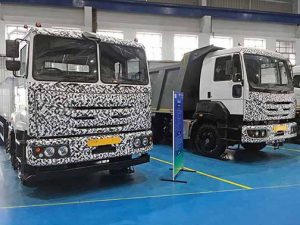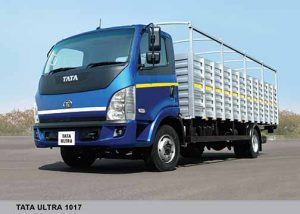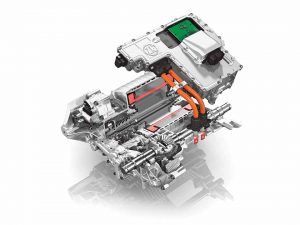Regulations and market requirements are driving modularisation in CVs.
Bhushan Mhapralkar
By showcasing BSVI CVs on a new modular platform, Ashok Leyland has highlighted a significant shift taking place in the CV landscape in India. By highlighting its efforts to drive modularisation, which primarily pertains to the chassis and the creation of common interfaces in connection, the CV maker has pointed at how regulations like BSVI are influencing the shift. Choosing to migrate one modular platform rather than three platforms and the many variants, Ashok Leyland has highlighted the way it has sought its BSVI journey in a low volume, high mix market. Empowering its customers to configure a medium or heavy-duty CV to his requirement, the company, according to Dr. N Saravanan, Chief Technology Officer, Ashok Leyland, has made it easier to customize products. Packaging the innovative BSVI Mid-NOx technology that combines iEGR and SCR technology, the new modular platform, will enable the company to further accelerate its export strategies by building CVs with different drive orientation (left and right). The new modular platform is also claimed to help the CV major nurture an ability to apply new technologies at a competitive cost; to incorporate higher manufacturing efficiency, and streamline various processes.
Successfully streamlining processes and supply chain management, CV manufacturers the world over have used modularisation to their benefit. Elevating the reliability, efficiency, and productivity of their vehicles, they have been able to drive agility. Leveraging modularisation to enhance profitability and to achieve superior sustainability, CV makers in India are leaving no stone unturned to catch up with the rest of the world, by complying to BSVI. Keen to risk-averse against slowdowns, CV manufacturers in India, apart from keeping costs under control is looking at an opportunity to reduce the carbon footprint by practising TQM. Leveraging megatrends like the Internet of Things (IoT) and Artificial Intelligence (AI), modularisation is helping them to look at new ways to eliminate Muda, Mura, and Muri.
Touted as the first European CV manufacturer to offer Euro6 CVs to its customers, Scania has been well-acknowledged for its efforts to modularise. Behind its strategy to modularise is said to be the need to attain flexibility, speed to market, and cost-efficiency. Claimed to nurture an ability to provide individual product configurations for each customer with a limited number of parts by having common interfaces, the Swedish CV maker planned the engine compartment and the cab to accommodate the cooling need and equipment for Euro6 such that it could fit the space available without any need for design changes on the cab structure. Claimed an industry source, that Scania leveraged modularisation to stay competitive in an industrial space that is regarded as the most competitive of them all. It continues to do so even today, he added.
Cost and complexity
Leveraging the modular approach to add value and keep costs under control, Scania, for example, has used standardised windshield for its cabs. It has done so in many other areas too. In India, the level of modularisation is not as high. A close look at the Ashok Leyland’s new modular platform will reveal that modularisation is at the chassis level primarily. If the BSVI regulatory compliance has influenced it, it has also highlighted how CV makers like Mahindra & Mahindra (Truck & Bus Division) have been practising it. According to Venkat Srinivas, Senior Vice President – Product Development, Mahindra Truck and Bus Division, M&M Ltd. the modular approach is not only aiding CV makers, suppliers and other stakeholders of the CV industry to streamline their process, it is also helping them to rationalise their product offerings. To achieve high-efficiency gains, modularisation is supporting the Indian CV industry’s ambition to go global. It is presenting the industry a rare chance to showcase its ability to low-cost engineer Euro6 equivalent CVs, aggregates and components.
Providing the Indian CV industry to explore new markets, modularisation is helping it to explore new avenues. Demonstrating its tryst with modularisation through its two key platforms – the Prima (which began its journey as the World Truck Programme in association with Tata Daewoo) and Ultra, Tata Motors has come a long way. Modularising its legacy platform, the Signa, the company has used a set of common aggregates and components across variants. It has engineered common interfaces. Drawing attention to the Intra small truck platform, an industry source mentioned that, Tata Motors has practised modularisation and Super APP Framework in-house. It has captured customer requirements and has configured them into its vehicle range, they inform. Into massive customisation to provide a ‘Vehicle of Choice’ to its customers, the CV major is said to be looking at up to 80 per cent commonality of parts.
Working closely with its suppliers to ensure that the aggregates (modules) are suitable for use across vehicle segments, are effective in keeping costs under control, Tata Motors, explained an industry source, is addressing vehicle complexity. It is reducing the need to stock as many parts, he added. To increase overall efficiency as well as the efficiency of its partners, Tata Motors is claimed to look at the ease of manufacture. The CV major, through modularisation, is said to look at progressive standardisation in the form of easily interchangeable interfaces. It is known to look at short and specific vehicle series runs with a modular approach to address specific needs, and to provide an opportunity to ‘mix and match’ in a highly regulated environment. Making it easy to build CVs with multi-axles, build trucks with six axles for example, out of which four are powered, CV majors, through modularisation, are cultivating an ability to roll out changes and features quickly and reliably. Mentioned a source, that modularisation is making it easy to build a truck with a powerful engine; is making it easy to build a bus with a low chassis; is making it easy to build a small cab; is providing some rare abilities in terms of costs and engineering.
Favourable cost structure
 Providing an opportunity where the front steering axle of a tractor could be applied as a trailing axle of a bus, modularisation is claimed to provide a favourable cost structure. It could prove out tricky too in terms of designing a component either. A component that can be used in many CVs. Stated an industry source, that modularisation is not as easy as it seems. It calls for an amount of anticipation in terms of the future, he added. Claiming that Ashok Leyland has mapped regulations that could follow BSVI (like the implementation of real-world driving emissions by 2023) while developing the new modular platform, an industry source said that the CV major also looked at the changing dynamics of the market in terms of customer requirements. He pointed at how the CV manufacturer worked with its suppliers to ensure the necessary advantage. Providing an opportunity to localise quickly, modularisation is claimed to help achieve higher volume per component too. It is also said to provide an opportunity to go lean. Cited an industry expert, the example of Volvo Eicher Powertrain Ltd. (a Volvo Eicher joint venture). It has been turning out Euro6 base engines for Volvo Group consumption since 2013 and has now started supplying BSVI engines to VE Commercial Vehicles Ltd. for its M&HCVs.
Providing an opportunity where the front steering axle of a tractor could be applied as a trailing axle of a bus, modularisation is claimed to provide a favourable cost structure. It could prove out tricky too in terms of designing a component either. A component that can be used in many CVs. Stated an industry source, that modularisation is not as easy as it seems. It calls for an amount of anticipation in terms of the future, he added. Claiming that Ashok Leyland has mapped regulations that could follow BSVI (like the implementation of real-world driving emissions by 2023) while developing the new modular platform, an industry source said that the CV major also looked at the changing dynamics of the market in terms of customer requirements. He pointed at how the CV manufacturer worked with its suppliers to ensure the necessary advantage. Providing an opportunity to localise quickly, modularisation is claimed to help achieve higher volume per component too. It is also said to provide an opportunity to go lean. Cited an industry expert, the example of Volvo Eicher Powertrain Ltd. (a Volvo Eicher joint venture). It has been turning out Euro6 base engines for Volvo Group consumption since 2013 and has now started supplying BSVI engines to VE Commercial Vehicles Ltd. for its M&HCVs.
Automation
Being pursued as a technique to derive higher profitability, modularisation is driving an ability to be flexible. This is necessary to keep the development costs low and serve the market efficiently, according to Srinivas. Aiding the retrofitting of select features, where ever feasible, and depending on whether it is driven by customer requirement or by regulation, modularisation is helping tackle the challenge of higher profitability and productivity. It is helping to better package disruptive technologies like hybridisation and electrification in CVs. It is also helping to implement renewable energy resources and technologies like battery swapping and quick charging. Drawing attention to the development of an ‘E-Drive’ by ZF, the industry expert stressed on how tier automotive suppliers are contributing to modularisation. Consisting of an electric motor, software and power electronics, the ‘E-Drive’ is designed to address the requirements of high-volume production electric CVs. With its highly modular power electronics, it is enabling the matching of solutions to the design space. Driving new ideas and concepts in CVs combining the ability to design and automate, modularisation is empowering engineers to develop new concepts. It is aiding a move towards zero-emission future.
 Building trucks in Brazil since 1996 by employing modular strategies, Volkswagen is experimenting with an electric delivery van to highlight some unique productivity advantages for example. It is making it viable to outsource some of the production responsibility to vendors and also share some of the investment costs in the process. Proving to be of advantage to CV majors, modularisation is thus helping CV makers and other stakeholders to evaluate the real-world use of autonomous CVs. It is also helping them to do so as per the need of the hour. Helping the CV industry – OEMs, suppliers, and other stakeholders, to experiment with new materials, modularisation is also enabling light-weight and save resources; help care for the environment and the need to design from scratch. Providing an opportunity to upgrade, modularisation is helping CV majors like Scania and MAN to collaborate in the use of key aggregates like engines, axles, transmissions and others. The two are jointly developing an engine platform for its heavy-duty CVs using Common Base Engine 1. Migrating its 7.2-litre engine to BSVI, Mahindra Truck and Bus division is, as part of its modularisation strategy, is working towards 80 per cent commonality of aggregates.
Building trucks in Brazil since 1996 by employing modular strategies, Volkswagen is experimenting with an electric delivery van to highlight some unique productivity advantages for example. It is making it viable to outsource some of the production responsibility to vendors and also share some of the investment costs in the process. Proving to be of advantage to CV majors, modularisation is thus helping CV makers and other stakeholders to evaluate the real-world use of autonomous CVs. It is also helping them to do so as per the need of the hour. Helping the CV industry – OEMs, suppliers, and other stakeholders, to experiment with new materials, modularisation is also enabling light-weight and save resources; help care for the environment and the need to design from scratch. Providing an opportunity to upgrade, modularisation is helping CV majors like Scania and MAN to collaborate in the use of key aggregates like engines, axles, transmissions and others. The two are jointly developing an engine platform for its heavy-duty CVs using Common Base Engine 1. Migrating its 7.2-litre engine to BSVI, Mahindra Truck and Bus division is, as part of its modularisation strategy, is working towards 80 per cent commonality of aggregates.
Engineering its Jeeto SCV platform and the Furio light and intermediate CV to spring different variants to address the dynamic needs of operators, M&M is said to be smartly utilising the modular approach. Claimed a source that the Blazo is a prime example of how M&M is leveraging the strategy to modularise CVs. Mentioned Srinivas, that modularisation is a critical enabler in terms of models and variants where application-specific variants would define success or failure. Modularisation has helped improve time to market and ensure efficient designs that prove profitable, he added. Stating that BSVI has accelerated modularisation of CVs in India because of the need to optimise cost, complexity, spare parts availability and service readiness, Srinivas revealed that the Mahindra Truck and Bus Division (MTBD) has been practising modularisation from an early stage. He expressed that they visited the chassis platform and vehicle architecture (both mechanical and electronic architecture) for the purpose. This involved the frame width and cross-section as the initial building blocks. The exercise extended itself to the engine position and right down to the engine flywheel position; to driveline installation, and to the clutch and transmission.
Encompassing the length of the vehicle, the efforts to modularise included the cabin as well. Different cabin variants were engineered to ensure significant gains in efficiency, averred Srinivas. He said that it ensured better turn-around time for customers. Of the opinion that modularisation has helped in terms of regulations, Srinivas explained that it has cut down the need to get different platforms to upgrade. “It has also helped to integrate the electronics (such as multiple ECUs, ABS, ESC, and others) better,” he added. Demonstrating the advantage of modularisation, CVs like Mahindra Jeeto and Blazo, or the Tata Intra and Ultra, reflect the progress the Indian CV industry has achieved despite the challenging environment. CVs like the ones built on the new modular platform from Ashok Leyland is an indication of how modularisation is helping the OEMs, their suppliers, dealers, and customers to enable better profitability. With CV makers like Scania highlighting the success of modularisation through their ability to break into new markets and segments cost-effectively, thereby laying the groundwork for profitable growth, the future of CVs in India has suddenly started to look interesting.
























